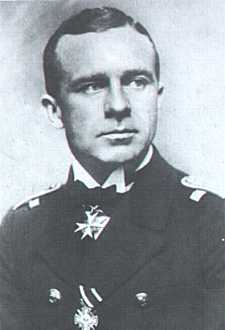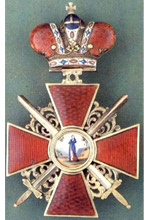Decorations
Order of St. Anna (Russia)
| The Order of St. Anna (also "Order of Saint Ann" or "Order of Saint Anne") is a Holstein and then Russian Imperial order of chivalry established by Karl Friedrich, Duke of Holstein-Gottorp on 14 February 1735, in honour of his wife Anna Petrovna, daughter of Peter the Great of Russia. The motto of the Order was "Amantibus Justitiam, Pietatem, Fidem" ("To those who love justice, piety, and fidelity"). Its festival day is 3 February (16 February by New Style). This Order originally is a Dynastic order of knighthood, but from 1797 to 1917 is has dual status as an dynastic order and as an State Order. The Head of Imperial House of Russia always hold a position of the Head of Imperial Order of St.Anna. Membership of the Order awarded for a distinguished career in civil service or for valour and distinguished service in the military. The Order of Saint Anne entitled first class recipients to hereditary nobility while other recipients to personal nobility. For military recipients, it awarded with swords. At first, the order had but one class and was named the "Order of Anna". The statutes of the Order promulgated in 1735 established as the principal insignia a red-enameled gold cross, with an image of Saint Ann imposed upon the centre of the cross; the reverse bore the initials "A.I.P.F." (for "Anna Imperatoris Petri Filia": "Anna, Emperor Peter's daughter" in Latin). The same letters also abbreviate the Latin motto (as the letter "J" did not exist in Latin, "Iustitiam" was the original spelling of the word now rendered "Justitiam"). In 1742, Karl Peter Ulrich, Duke Karl Friedrich's son, was declared the Russian heir apparent. After arriving in Russia, he presented the Order to several courtiers. On 15 April 1797, his own son, Emperor Paul I of Russia, established the Order as part of the Imperial Russian system of honours and divided it into three classes, renaming it the "Order of Saint Anna". Emperor Alexander I added a fourth class in 1815. Recipients of the Order of St. Andrew (including princes of the Imperial blood, who received it at baptism) simultaneously received the first class of the Order of Saint Anna. The Emperor himself was the hereditary chief of the Order. The title of Chekhov's well-known story Anna on the Neck refers both to the Order and to the heroine. |
| Commander | Date | Command | |||
|---|---|---|---|---|---|
| Oblt. | Rabenau, Helmuth von | 18 Nov 1912 | |||
| Oblt. | Saalwächter, Alfred | 9 May 1910 | |||
| Kptlt. | Zitzewitz, Gerhard von | 12 Jul 1909 | |||
3 officers decorated with Order of St. Anna (Russia) located.
Note: This listing is still being compiled and some recipients might be missing.


